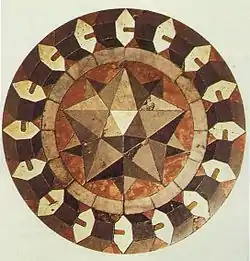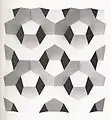Voderberg tiling
The Voderberg tiling is a mathematical spiral tiling, invented in 1936 by mathematician Heinz Voderberg.[1] It is a monohedral tiling, meaning that it consists of only one shape, tessellated with congruent copies of itself. In this case, the prototile is an elongated irregular nonagon, or nine-sided figure. Because it has no translational symmetries, the Voderberg tiling is technically non-periodic, even though it exhibits an obvious repeating pattern.

A partial Voderberg tiling. Note that all of the colored tiles are congruent.
This tiling was the first spiral tiling to be devised,[2] preceding later work by Branko Grünbaum and Geoffrey C. Shephard in the 1970s.[1] A Voderberg tiling is depicted on the cover of Grünbaum and Shephard's 1987 book Tilings and Patterns.[3]
| Wikimedia Commons has media related to Voderberg spiral tiling. |
References
- Pickover, Clifford A. (2009). The Math Book: From Pythagoras to the 57th Dimension, 250 Milestones in the History of Mathematics. Sterling Publishing Company, Inc. p. 372. ISBN 9781402757969. Retrieved 24 March 2015.
- Dutch, Steven (29 July 1999). "Some Special Radial and Spiral Tilings". University of Wisconsin, Green Bay. Archived from the original on 5 March 2016. Retrieved 24 March 2015.
- Grünbaum, Branko; Shephard, G. C. (1987), Tilings and Patterns, New York: W. H. Freeman, Section 9.5, "Spiral Tilings," p. 512, ISBN 0-7167-1193-1.
External links
- Cye H. Waldman (9 September 2014). "Voderberg Deconstructed & Triangle Substitution Tiling".
This article is issued from Wikipedia. The text is licensed under Creative Commons - Attribution - Sharealike. Additional terms may apply for the media files.


